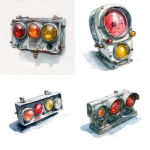Explore the Best AI Image Gallery

Beyond the Canvas: How VR and AR are Reshaping Gaming and the Creative Industry
The gaming industry has always been a crucible of innovation, constantly pushing the boundaries of technology and storytelling. Recently, virtual reality (VR) and augmented reality (AR) have emerged as transformative forces, blurring the lines between the digital and physical worlds and redefining how we create and experience games. This evolution extends far beyond entertainment, impacting the creative industry as a whole.
A New Playground for Creativity
VR and AR offer game developers an unprecedented level of creative freedom. Imagine crafting immersive worlds where players can truly inhabit different realities, interact with characters in a tangible way, and experience narratives in groundbreaking new forms.
- Immersive Storytelling: VR allows developers to transport players directly into the heart of the story, fostering a deeper emotional connection and enhancing engagement.
- Interactive Environments: Games can be transformed into living, breathing worlds where players can explore, interact with objects, and influence the narrative through their actions.
- Enhanced Collaboration: AR allows for shared experiences, enabling multiple players to collaborate and create within the same virtual space.
Applications Beyond Gaming
The potential of VR and AR extends far beyond the realm of gaming. Artists, designers, architects, and educators are harnessing these technologies to explore new creative avenues:
- Virtual Art Galleries: Showcase artwork in immersive 3D environments, allowing viewers to experience pieces from different angles and perspectives.
- Interactive Design Prototypes: Architects and product designers can create virtual prototypes for testing and refining their creations before physical production.
- Augmented Learning Experiences: Integrate AR into educational settings to provide interactive simulations, virtual field trips, and engaging learning tools.
Ethical Considerations
As with any powerful technology, VR and AR raise ethical considerations that need careful attention:
- Privacy Concerns: The collection of user data in immersive environments raises questions about privacy and how this information is used.
- Virtual Bias: Ensuring that virtual worlds are inclusive and representative, avoiding the perpetuation of harmful stereotypes or biases.
- Addiction and Health Impacts: Excessive use of VR and AR could lead to addiction, eye strain, or other health issues. Its crucial to promote responsible use and balance.
The Future of Creative Expression
The convergence of VR, AR, and gaming heralds a future where creativity knows no bounds. As technology advances, we can expect:
- More Realistic and Immersive Experiences: Advancements in graphics, haptic feedback, and sensor technology will create increasingly realistic and engaging virtual worlds.
- Personalized Creative Tools: AI-powered tools will empower individuals to create their own games, art, and interactive experiences with greater ease.
- The Rise of the Metaverse: Persistent virtual worlds that blur the lines between gaming, social interaction, and commerce are likely to become increasingly prevalent.
VR and AR are not just about entertainment; they represent a paradigm shift in creative expression. By embracing these technologies responsibly, we can unlock new possibilities for storytelling, artistic exploration, and collaborative innovation.

](https://images.ai-img.art/thumbnails/150/3e8c063b4357fc743a3c6e49a3145ee31b2dcecc018c38d2db8f97bf3e3fda3f.webp)


](https://images.ai-img.art/thumbnails/150/1accb5453f2335686b162f0a879c7ce73a18516a33868f214a16bdaf95beeb5a.webp)







](https://images.ai-img.art/thumbnails/150/3c5dc62bba83cc9919c20ebfec8430d31e821cef586a2753dd85ef26d77d480a.webp)


](https://images.ai-img.art/thumbnails/150/8c320ce9aefbbb5b9ec5fd4e1d0fba7388f0fff5b6c2e2f14077cad3008f291d.webp)





](https://images.ai-img.art/thumbnails/150/1d7b3a908141474d50d90721c394db29c0cb5404d685ae70ea60430c18e905b7.webp)

